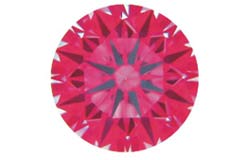Contact
Click below to speak to a Diamond Consultant or customer service.
or
Live Chat8:00 am - 6:00 pm CST (Mon - Fri)

Click below to speak to a Diamond Consultant or customer service.
or
Live Chat8:00 am - 6:00 pm CST (Mon - Fri)
The hearts and arrows pattern (often marketed under brand names such as 'Hearts on Fire') refers to a symmetrical light pattern visible using a specialized viewer in diamonds cut within certain narrow specifications.

The hearts and arrows pattern was first viewed using a Firescope; a tool developed by Kazumi Okuda in the 1970s. Firescopes and their modern equivalents (such as the H&A Viewer, Ideal-scope and ASET-scope) use colored reflectors to display a pattern showing the direction and intensity of light emitted from a diamond. These colorful patterns can be evaluated to determine how much light is exiting the diamond at proper angles, and whether the diamond is optically symmetrical (indicated by a uniform pattern).

In the example at left, red represents light being emitted from the diamond in a direction and intensity that will be perceived by the viewer as brightness. Pink areas represent areas of less brightness. Dark areas indicate areas where light is blocked by the viewers head (these areas are perceived as dark flashes, or scintillation, when the viewer or the diamond moves). Finally, white areas indicate where light is traveling through the diamond, and 'leaking' out of the bottom (perceived as dull or dark areas in the diamond). Different types of viewers will use different color schemes, but all produce similar patterns.

One possible pattern is what is today marketed as "hearts and arrows". The "arrows" are visible when the diamond is viewed from the top. The "hearts" are visible when the diamond is flipped over and viewed from the bottom.
The hearts and arrows pattern was initially noticed by accident; the name first coined by Kinsaku Yamashita, and eventually trademarked in 1988, the birth of the hearts and arrows marketing campaign. The hearts and arrows phenomenon quickly spread from Japan to the U.S in the early 1990s. The hearts and arrows pattern is now so popular that many diamond manufactures cut to a specification that will yield this particular pattern, even at the expense of overall cut quality.
The intrinsic appeal of the hearts and arrows pattern, with its association to Cupid, is obvious; even if the heart pattern is invisible once the diamond is set. Often the presence of the hearts and arrows pattern is taken as confirmation that the diamond is well cut. This is not necessarily true. In a round diamond, a clearly defined set of 8 hearts and 8 arrows is a sign of excellent optical symmetry, an important component of cut. As such, its appearance is a very likely a sign of superior cut, but not a guarantee.
Consumers are often misled regarding the quality of a hearts and arrows pattern. While a diamond may display what appears to be a pronounced hearts and arrows effect, several subtle details in the shape, spacing, and positioning of the pattern can have a significant impact on desirability and therefore value. These variations are often not detectable by any except experienced graders or jewelers.
Even so, the marketing impact of the hearts and arrows campaign has been profound. Because well cut diamonds are rare to begin with, and diamonds with the particular hearts and arrow pattern rarer still, H&A diamonds carry a premium price. This is due not only to effective marketing, but because all well cut diamonds (including H&A) require more time to cut, and generate about 15% more waste than lower quality cuts.
For consumers, the greatest benefit of the popularity of hearts and arrows is actually the increased attention brought to the grading of cut. In the late 90s, major labs (including GIA) quickly perceived the demand for a cut grade by customers newly educated to the importance of cut and symmetry in the overall appearance of a diamond. Today, independent laboratory cut grades are the single biggest factor in helping customers to distinguish quality (beyond color and clarity) in diamonds.
GIA does not recognize hearts and arrows as a component of cut grade. This is partly due to the fact that the presence of the pattern is not a guarantee of cut. Occasionally you will see a hearts and arrows notation on a GIA certificate. This is simply GIA noting that an H&A inscription is present on the girdle of the diamond. This is provided as information only, not as a confirmation of the presence or quality of any hearts and arrows pattern in the diamond itself.
At Lumera, we believe the best approach to hearts and arrows is not to be carried away by the marketing of the pattern. One of the reasons GIA (and AGS) do not incorporate or acknowledge H&A in their grading is that it has never been shown to be preferred by consumers in blind tests. While the pattern has an emotional appeal, its actual affect on appearance is debated.
A Lumera diamond consultant would be happy to locate true hearts and arrows diamonds for customers who attach a high value to this particular pattern, and also to find high performance diamonds of similar patterns for customers who value the concept behind hearts and arrows if not necessarily the pattern itself. A consultant will answer any questions you have, and if you like, search for diamonds on your behalf that match your criteria. chat online, or email [email protected].
SEARCH FOR A DIAMOND NOW
